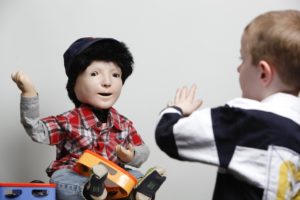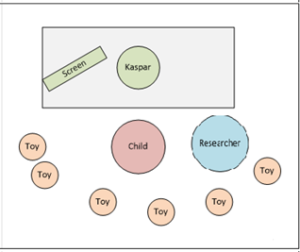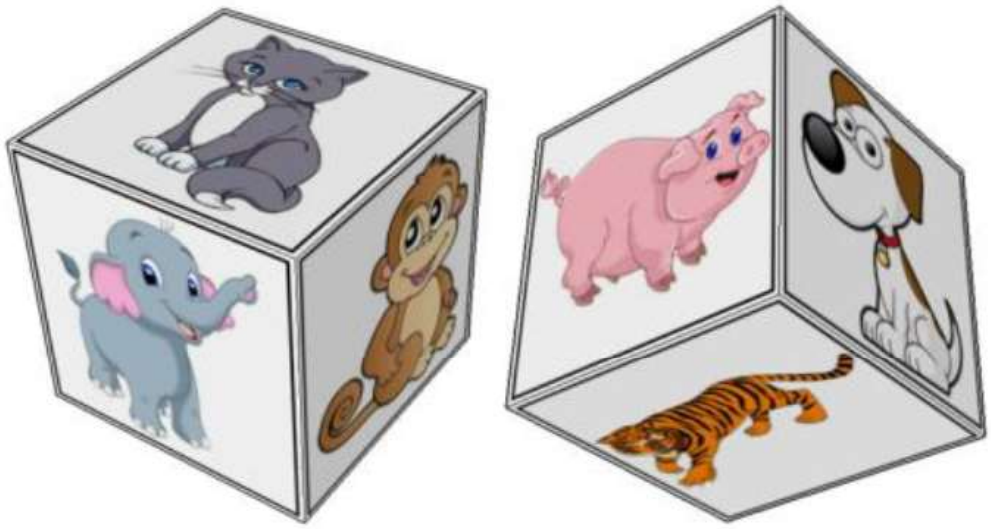Researchers from the Adaptive Systems Research Group at the University of Hertfordshire are about to bring a Kaspar robot to Garston Manor, a specialist school for autism, learning difficulties, and speech and language.
 The TAS Pump Priming project “Kaspar explains” uses the state-of-the-art social robot Kaspar to see whether explanations might help persons with autism better understand cause and effect. The idea behind this project is that Kaspar can be a trustworthy educational tool for children, their parents, and their teachers if it uses explanations.
The TAS Pump Priming project “Kaspar explains” uses the state-of-the-art social robot Kaspar to see whether explanations might help persons with autism better understand cause and effect. The idea behind this project is that Kaspar can be a trustworthy educational tool for children, their parents, and their teachers if it uses explanations.
Children with autism often struggle to understand the consequences of their actions, especially when interacting with others. In an interactive session with Kaspar, an autistic child and a researcher will investigate whether certain explanations can have a positive effect on the robot’s trustworthiness. Miss Christine deGraft-Hanson, the Headteacher of Garston Manor, who is also involved in the “Kaspar Explains” project commented:
“The goal of this project is to establish the salient factors in providing explanations in social interactions and their richness to further develop educational tools supporting the required learning for children with autism.”
In a retrospective study, the project team systematically analysed recordings of previous sessions to identify cases where either a researcher or Kaspar have used causal explanations in interaction with children with autism. Such cases have been found to occur frequently in scenarios related to Visual Perspective Taking skills, that relate to the ability to view the world from another individual’s perspective, considering what they see and how they see it, and which might present difficulties to persons with Autism. These scenarios have been adapted as games for the upcoming study.
 In one of the games, children can learn that Kaspar has a line of sight that differs from their own. With the help of a monitor that displays what Kaspar can see, children can explore what happens if they move an object into the robot’s field of view as the object becomes immediately visible on the screen. Kaspar, sitting on a desk, will ask the child about various animals that have been placed around the room as laminated pictures. The robot encourages the child to find the picture of one of the animals and show it to Kaspar.
In one of the games, children can learn that Kaspar has a line of sight that differs from their own. With the help of a monitor that displays what Kaspar can see, children can explore what happens if they move an object into the robot’s field of view as the object becomes immediately visible on the screen. Kaspar, sitting on a desk, will ask the child about various animals that have been placed around the room as laminated pictures. The robot encourages the child to find the picture of one of the animals and show it to Kaspar.
In another game, which relates to the understanding that two or more people viewing the same object from different points in space might see different things, Kaspar asks the child to show him a picture of an animal on a cube. In this scenario, the child needs first to find the side of the cube with the required animal and then turn the cube around so Kaspar can see it whilst the child sees a different animal on the cube at that time. If the child completes either game successfully, Kaspar applauds them and makes the sound of the animal. Otherwise, Kaspar uses explanations to support the child until it finds the correct animal and places it correctly in the robot’s field of view.
points in space might see different things, Kaspar asks the child to show him a picture of an animal on a cube. In this scenario, the child needs first to find the side of the cube with the required animal and then turn the cube around so Kaspar can see it whilst the child sees a different animal on the cube at that time. If the child completes either game successfully, Kaspar applauds them and makes the sound of the animal. Otherwise, Kaspar uses explanations to support the child until it finds the correct animal and places it correctly in the robot’s field of view.
This upcoming study will gather necessary insights into the utility of explanations in educational and therapeutical interactions with the Kaspar robot. Together with Prof. Mousavi from King’s College London and the TAS node on Verifiability, the project explores if explanation and user’s satisfaction can be utilised to improve trust, using formal verification methods. Data generated from this pilot study will be fed into a toolkit that analyses success of different explanations in sequence of actions between Kaspar, the researcher, and the child. This will result in identifying the most suitable explanation for an individual interaction.
For more information on the “Kaspar explains” project, please get in touch with the principal investigator Farshid Amirabdollahian.